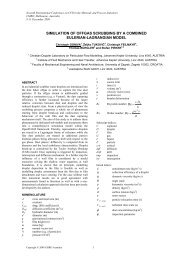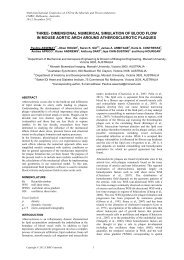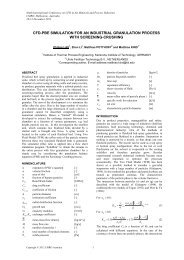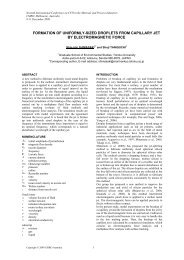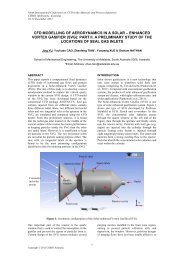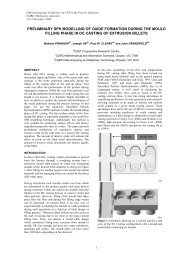Computational aero-acoustics of vehicle a-pillar at - CFD
Computational aero-acoustics of vehicle a-pillar at - CFD
Computational aero-acoustics of vehicle a-pillar at - CFD
You also want an ePaper? Increase the reach of your titles
YUMPU automatically turns print PDFs into web optimized ePapers that Google loves.
Fifth Intern<strong>at</strong>ional Conference on <strong>CFD</strong> in the Process Industries<br />
CSIRO, Melbourne, Australia<br />
13-15 December 2006<br />
ABSTRACT<br />
COMPUTATIONAL AERO-ACOUSTICS OF VEHICLE A-PILLAR AT VARIOUS<br />
WINDSHIELD RADII<br />
Nurul M. MURAD 1 , Jamal NASER 1 , Firoz ALAM 2 and Simon WATKINS 2<br />
Flow separ<strong>at</strong>ion behind the A-<strong>pillar</strong> region can lead to<br />
<strong>aero</strong>-<strong>acoustics</strong> gener<strong>at</strong>ion, which presents problems such<br />
as annoyance and discomfort to <strong>vehicle</strong> occupants<br />
(Hucho, 1998). The propag<strong>at</strong>ion <strong>of</strong> <strong>aero</strong>dynamic noise<br />
surrounding the <strong>vehicle</strong> can be modelled numerically in<br />
order to investig<strong>at</strong>e the <strong>aero</strong>-<strong>acoustics</strong> source and hence<br />
minimise the problems. This paper <strong>at</strong>tempts to investig<strong>at</strong>e<br />
one <strong>of</strong> the several methods available to model <strong>aero</strong><strong>acoustics</strong><br />
propag<strong>at</strong>ion. In this paper, three generic <strong>vehicle</strong><br />
scale models with different windshield radii were used as<br />
a case study and modelled using CAA under labor<strong>at</strong>ory<br />
oper<strong>at</strong>ing conditions. CAA modelling was conducted<br />
using a commercial code called AVL SWIFT-CAA. AVL<br />
SWIFT-CAA <strong>of</strong>fered a more economical avenue to model<br />
for CAA. Investig<strong>at</strong>ions were carried out <strong>at</strong> inlet velocity<br />
<strong>of</strong> 60, 100 and 140km/h <strong>at</strong> 0º and 15˚ yaw angles.<br />
Comparisons were conducted between CAA results and<br />
experimental results <strong>of</strong> Alam (2000) to investig<strong>at</strong>e the<br />
capabilities <strong>of</strong> the SWIFT-CAA modelling capabilities.<br />
NOMENCLATURE<br />
<strong>CFD</strong> <strong>Comput<strong>at</strong>ional</strong> Fluid Dynamics<br />
CAA <strong>Comput<strong>at</strong>ional</strong> Aero-Acoustics<br />
RANS Reynolds Average Navier Stokes Equ<strong>at</strong>ions<br />
LEE Linearized Euler Equ<strong>at</strong>ions<br />
C p RMS Root Mean Square Coefficient <strong>of</strong> Pressure<br />
PSD Power Spectral Density<br />
INTRODUCTION<br />
Flow separ<strong>at</strong>ion behind the <strong>vehicle</strong> A-<strong>pillar</strong> region can<br />
lead to <strong>aero</strong>-<strong>acoustics</strong> gener<strong>at</strong>ion. Aero-<strong>acoustics</strong><br />
gener<strong>at</strong>ed is then transferred to the passenger cabin<br />
causing annoyance and much discomfort to the <strong>vehicle</strong><br />
occupants (Hucho, 1998).<br />
The propag<strong>at</strong>ion <strong>of</strong> <strong>aero</strong>dynamic noise surrounding the<br />
exterior and interior <strong>of</strong> the <strong>vehicle</strong> can be modelled<br />
numerically. One method <strong>of</strong> <strong>aero</strong>-<strong>acoustics</strong> modelling is to<br />
use either DNS or LES <strong>CFD</strong> modelling. The performance<br />
<strong>of</strong> these methods however, is limited by the sp<strong>at</strong>ial and<br />
temporal resolution th<strong>at</strong> can be achieved in order to<br />
effectively model the required frequency and amplitude<br />
range, Tam (2002), Lokhande et al. (2003).<br />
The other method <strong>of</strong> <strong>aero</strong>-<strong>acoustics</strong> modelling involve<br />
extracting acoustical source term from either a transient or<br />
steady <strong>CFD</strong> model and calcul<strong>at</strong>e the propag<strong>at</strong>ion <strong>of</strong><br />
<strong>aero</strong>dynamic noise <strong>at</strong> the far-field receiver using an<br />
acoustic solver. Lyrintzis (1994) and Kumarasamy et al.<br />
1 Faculty <strong>of</strong> Engineering and Industrial Science<br />
Swinburne University <strong>of</strong> Technology, VIC, 3122 AUSTRALIA<br />
2 School <strong>of</strong> Aerospace, Mechanical and Manufacturing Engineering<br />
RMIT University, VIC, 3083 AUSTRALIA<br />
(1999) defined this method as the acoustic-analogy<br />
method and listed several <strong>of</strong> the different techniques<br />
available, namely the Lighthill Acoustic Analogy (LAA)<br />
Method, Kirch<strong>of</strong>f Method, Pertub<strong>at</strong>ion Method and the<br />
Linearised Euler Equ<strong>at</strong>ion (LEE) Method.<br />
This purpose <strong>of</strong> this paper is to investig<strong>at</strong>e the capability<br />
<strong>of</strong> a CAA modelling code called the hybrid SWIFT-CAA,<br />
developed by AVL/TNO. The hybrid SWIFT-CAA<br />
approach <strong>of</strong>fers a novel way to economically model <strong>aero</strong><strong>acoustics</strong><br />
by using RANS-<strong>CFD</strong> d<strong>at</strong>a coupled with a<br />
st<strong>at</strong>istical model as a basis to solve for the acoustical<br />
source term. This bypass the need to gener<strong>at</strong>e a transient<br />
<strong>CFD</strong> model th<strong>at</strong> utilises a comput<strong>at</strong>ional domain with high<br />
order sp<strong>at</strong>ial and temporal resolution needed to solve for<br />
<strong>aero</strong>-<strong>acoustics</strong> propag<strong>at</strong>ion th<strong>at</strong> extends to the far field<br />
range.<br />
The capabilities <strong>of</strong> the hybrid SWIFT-CAA was<br />
investig<strong>at</strong>ed through comparison with the experimental<br />
work <strong>of</strong> Alam (2000), in which measurement <strong>of</strong> C p RMS<br />
and PSD distribution behind the <strong>vehicle</strong> A-<strong>pillar</strong> region<br />
were obtained. Alam (2000) used three generic <strong>vehicle</strong><br />
scale models with different circular windshield radii and<br />
yaw orient<strong>at</strong>ions, subjected to various wind tunnel<br />
velocities.<br />
The following section will describe the methodology used<br />
in this study. This includes the general description <strong>of</strong> the<br />
hybrid SWIFT-CAA approach and the str<strong>at</strong>egy used for<br />
the CAA modelling. The results and discussion are then<br />
presented through comparison <strong>of</strong> C p RMS and PSD results<br />
distribution <strong>at</strong> 0˚ and 15˚ yaw between the experime ntal<br />
and CAA modelling approach <strong>of</strong> surface acoustic<br />
fluctu<strong>at</strong>ing pressure behind the model A-<strong>pillar</strong> region.<br />
1<br />
METHODOLOGY<br />
The methodology <strong>of</strong> the hybrid SWIFT-CAA approach<br />
can be c<strong>at</strong>egorised into two steps. The first step consists <strong>of</strong><br />
gener<strong>at</strong>ion <strong>of</strong> acoustical source term by mean <strong>of</strong><br />
transferring 3D st<strong>at</strong>istical turbulent quantities obtained<br />
from RANS-<strong>CFD</strong> modelling to a separ<strong>at</strong>e CAA domain,<br />
meshed with unstructured tetrahedral grid <strong>of</strong> low density.<br />
The transfer <strong>of</strong> 3D st<strong>at</strong>istical turbulent quantities<br />
(turbulent kinetic energy, eddy length scale and<br />
dissip<strong>at</strong>ion r<strong>at</strong>e) were conducted using a st<strong>at</strong>istical model<br />
th<strong>at</strong> incorpor<strong>at</strong>e the inverse Fourier transform through a<br />
sub-routine in the CAA solver, called the Unstructured<br />
Kinem<strong>at</strong>ic Source Gener<strong>at</strong>or (UKSG). The st<strong>at</strong>istical<br />
model developed by Bechera (1996) and Long<strong>at</strong>te (1998)<br />
are given as:
N<br />
~<br />
u t ( x,<br />
t)<br />
= 2∑<br />
u ( + + )<br />
n=<br />
n cos κ nx<br />
ψ n ωnt<br />
σ (1)<br />
1<br />
n<br />
where σn is the direction <strong>of</strong> turbulent velocity vector,<br />
which is perpendicular to κn the wave vector. ωn is the<br />
radial frequency, ψn was a random phase and ữn is the<br />
model amplitude, which contains the st<strong>at</strong>istical turbulent<br />
quantities obtained from the RANS-<strong>CFD</strong> modelling.<br />
The equ<strong>at</strong>ion for turbulent fluctu<strong>at</strong>ions is then used to<br />
determine a time accur<strong>at</strong>e acoustic source term for the<br />
perturb<strong>at</strong>ion term <strong>of</strong> the mass, momentum and energy<br />
equ<strong>at</strong>ion:<br />
∂p<br />
∂t<br />
+<br />
∂ρ<br />
a<br />
+ ∇<br />
∂t<br />
∂ua<br />
+<br />
∂t<br />
ρ<br />
− (<br />
ρ<br />
a<br />
a<br />
2<br />
o<br />
+ ∇.<br />
'<br />
( ρ o u a + ρ aU<br />
o ) = S M − S 1<br />
. A<br />
( U o.<br />
∇)<br />
u a + ( u a.<br />
∇)<br />
U o<br />
pa<br />
∇po<br />
) + ( ∇ρ<br />
o ) = S I − S A2<br />
ρ<br />
2<br />
o<br />
( U o pa<br />
+ γ u a po<br />
) − ( γ −1)<br />
'<br />
( γ −1)<br />
pa<br />
∇.<br />
U o = S E − S A3<br />
(2)<br />
(3)<br />
u a.<br />
∇po<br />
(4)<br />
which represents the source terms with subscripts A1 to<br />
A3 in equ<strong>at</strong>ion 2 to 4.<br />
The final step in the SWIFT-CAA approach was to<br />
determine the <strong>aero</strong>-<strong>acoustics</strong> propag<strong>at</strong>ion (source to<br />
receiver in the far-field) through solving for the acoustic<br />
pressure (pa). Using the acoustic source terms, the CAA<br />
solver determine the <strong>aero</strong>-<strong>acoustics</strong> propag<strong>at</strong>ion using the<br />
LEE approach, which involves conversion <strong>of</strong> the terms on<br />
the right hand side <strong>of</strong> equ<strong>at</strong>ion 2 to 4, together with a time<br />
domain calcul<strong>at</strong>ion conducted using a Quadr<strong>at</strong>ure Free<br />
Discontinuous Galerkin Sp<strong>at</strong>ial discretiz<strong>at</strong>ion approach. In<br />
this approach, the revised source term obtained<br />
progressively <strong>at</strong> each time interval from the UKSG<br />
subroutine was interpol<strong>at</strong>ed to the CAA solver. A new<br />
time step interval was then obtained through the use <strong>of</strong> a<br />
fourth-order Runge-Kutta algorithm, AVL (2003).<br />
Vehicle Geometry and Boundary Conditions<br />
The geometry configur<strong>at</strong>ions and boundary conditions<br />
used in the <strong>CFD</strong> modelling, prior to the CAA modelling<br />
were obtained from Alam (2000). Generic scale (40%)<br />
<strong>vehicle</strong> models with varying local windshield radii namely<br />
Small Ellipsoidal (299-mm elliptic radius), Semi Circular<br />
(374-mm) and Large Ellipsoidal (449-mm) were<br />
constructed <strong>at</strong> yaw angle orient<strong>at</strong>ions <strong>of</strong> 0˚, -15˚ a nd +15˚<br />
respectively. The models were exposed to wind tunnel<br />
inlet velocities <strong>of</strong> 60, 100 and 140-km/h. The windshield<br />
for the models was <strong>at</strong> a slant angle <strong>of</strong> 60˚ from the vertical<br />
axis (Figure 1).<br />
The external surface <strong>of</strong> the CAA volume domain was<br />
assigned boundary conditions <strong>of</strong> either reflecting (wall <strong>of</strong><br />
the CAA domain) or non-reflecting (inlet and outlet <strong>of</strong> the<br />
CAA domain) (Figure 2). In the CAA domain, two rows<br />
(bottom and top row) <strong>of</strong> monitoring loc<strong>at</strong>ions (96-mm<br />
apart) were assigned to each model to capture fluctu<strong>at</strong>ing<br />
pressures behind the A-<strong>pillar</strong> region. Each row had 16<br />
monitoring points, which were 32.0-mm apart (Figure 1).<br />
2<br />
Figure 1: Simplified Vehicle Model Geometry with<br />
Varying A-<strong>pillar</strong> Windshield Radius (After Alam, 2000)<br />
Figure 2: Unstructured Tetrahedral Grids in CAA<br />
Domain Mesh Gener<strong>at</strong>ion<br />
AVL Fame Hybrid was used to gener<strong>at</strong>e grids for the<br />
CAA domain. The CAA domain was cre<strong>at</strong>ed by first<br />
selecting an area <strong>of</strong> interest surrounding the A-pilar region<br />
from within the <strong>CFD</strong> domain. The surrounding surface <strong>of</strong><br />
the selected CAA domain was first meshed with<br />
triangul<strong>at</strong>e surface grids. The CAA domain volume was<br />
then meshed with unstructured tetrahedral grids (Figure<br />
2). Each grid cell in the CAA domain must adhere to an<br />
aspect r<strong>at</strong>io <strong>of</strong> smaller than 3.3 in order to maintain<br />
optimum accuracy. Each tetrahedral grids gener<strong>at</strong>ed varies<br />
in between 50-mm to 100-mm in size.<br />
The final total grid count gener<strong>at</strong>ed varies in between<br />
14,000 to 35,000 depending on the model radius<br />
configur<strong>at</strong>ion and yaw angle orient<strong>at</strong>ion.<br />
Numerical Scheme and Str<strong>at</strong>egy<br />
The RANS-<strong>CFD</strong> modelling conducted using SWIFT-<strong>CFD</strong><br />
used a turbulence intensity and length scale value <strong>of</strong> 1.8%<br />
and 5.8 mm (1.0% model height) respectively. The<br />
numerical scheme used during the initial stage <strong>of</strong><br />
calcul<strong>at</strong>ion was first order upwind scheme and central<br />
differencing scheme. Once convergence was reached, the<br />
AVL smart bound higher order scheme was then used.<br />
The convergence level for residuals was set to 0.1% with<br />
SIMPLE pressure-velocity coupling used together with<br />
3D, steady and incompressible flow environment.<br />
Turbulence models used in the initial calcul<strong>at</strong>ion was<br />
standard k-ε before switching to the Reynolds Stress<br />
turbulence model (RSM). More details <strong>of</strong> the RANS-<strong>CFD</strong><br />
modelling conducted using SWIFT-<strong>CFD</strong> are well<br />
documented in Murad (2006) and will not be discussed<br />
further in this paper.
For CAA modelling conducted using SWIFT-CAA, a<br />
CAA Mapper sub-routine was first used to map the 3D<br />
st<strong>at</strong>istical turbulence quantities obtained from the <strong>CFD</strong><br />
results to the CAA domain. The CAA Mapper divided the<br />
CAA domain into several rectangular partitions or bins to<br />
expedite the mapping and interpol<strong>at</strong>ion process. The<br />
amount <strong>of</strong> <strong>CFD</strong> nodes interpol<strong>at</strong>ed in each bin must be<br />
sufficiently high to ensure an accur<strong>at</strong>e mapping. In this<br />
study, the node interpol<strong>at</strong>ion value was set as ten, the<br />
recommended default value. Once the mapping and<br />
interpol<strong>at</strong>ion process was complete, the CAA Mapper was<br />
then able to establish an initial time step to be used in the<br />
CAA solver. The initial time step was given autom<strong>at</strong>ically<br />
and was based on the formul<strong>at</strong>ion th<strong>at</strong> utilises the mean<br />
velocity together with the grid size and the Courant<br />
number.<br />
The time interval gener<strong>at</strong>ed for the CAA solver varies<br />
between 3.0 to 16.0 microseconds and required 160,000 to<br />
270,000 time steps to complete a total <strong>of</strong> 1.0-second time<br />
interval propag<strong>at</strong>ion.<br />
In setting up the CAA solver to simul<strong>at</strong>e for the<br />
<strong>aero</strong>dynamic acoustic propag<strong>at</strong>ion, the input parameters<br />
for Turbulence Realiz<strong>at</strong>ion Sampling Frequency was<br />
assigned a value <strong>of</strong> 40-kHz, which was the maximum<br />
allowed. This was close to the value <strong>of</strong> 48-kHz, which was<br />
used by Alam (2000).<br />
For this study, the simul<strong>at</strong>ion <strong>of</strong> the acoustic propag<strong>at</strong>ion<br />
carried out by the CAA solver took between one to four<br />
days to finish. Calcul<strong>at</strong>ion <strong>of</strong> the CAA solver for this<br />
project was done using a single processor in the<br />
Swinburne University Super Computer cluster.<br />
The results were analysed using post-processing fe<strong>at</strong>ures<br />
available in SWIFT-CAA. PSD analysis were conducted<br />
by providing input such as the number <strong>of</strong> Fourier Fast<br />
Transform (FFT) blocks, Number <strong>of</strong> FFT overlap points<br />
and viewing Window for each Fourier block. For this<br />
study, the inputs used were as follows:<br />
• Number <strong>of</strong> FFT blocks – 4096<br />
• Number <strong>of</strong> FFT overlap points – 50%<br />
• Viewing Window for each block – Hanning<br />
COMPARISON AND DISCUSSION OF CAA AND<br />
EXPERIMENTAL RESULTS<br />
CAA Modelling Results <strong>of</strong> Surface Fluctu<strong>at</strong>ing Pressure<br />
Small Ellipsoidal Model, Cp RMS and PSD Results<br />
Comparison <strong>of</strong> Cp RMS distribution obtained from CAA<br />
and experimental results for Small Ellipsoidal model <strong>at</strong> 0˚,<br />
-15˚ (Leeward) and +15˚ (Windward) yaw can be seen in<br />
Figures 3, 4 and 5. Good correl<strong>at</strong>ions were obtained for<br />
both bottom and top row monitoring loc<strong>at</strong>ions <strong>at</strong> 0˚ and<br />
+15˚ yaw. However, a small C p RMS discrepancy <strong>of</strong><br />
around 0.05 exists <strong>at</strong> -15˚ yaw towards the halfway point<br />
<strong>of</strong> the bottom row monitoring loc<strong>at</strong>ions and towards the<br />
end <strong>of</strong> the top row monitoring loc<strong>at</strong>ions respectively.<br />
Comparison <strong>of</strong> PSD distribution between CAA model and<br />
experimental results for Small Ellipsoidal model <strong>at</strong> 100<br />
km/h can be seen in Figures 6 and 7. The discrepancies<br />
obtained for peak PSD values for 0˚ yaw, +15˚ and -<br />
15˚yaw were 1.0, 3.0 and 14.0 dB respectively. The<br />
overall PSD distribution for Small Ellipsoidal model<br />
showed best correl<strong>at</strong>ion <strong>at</strong> yaw angle <strong>of</strong> +15˚, follo wed by<br />
yaw angles <strong>of</strong> 0˚ and -15˚, with total mean discrepa ncies<br />
measured <strong>at</strong> 5.0, 7.3 and 13.3-dB respectively.<br />
3<br />
Cp RMS<br />
Comparison <strong>of</strong> Cp RMS <strong>of</strong> Numerical and Experimental Results for<br />
Reynolds Number Sensitivity, Small Ellipsoidal Model, 0 Yaw<br />
0.20<br />
0.15<br />
0.10<br />
0.05<br />
0.00<br />
-1.1 -1.0 -0.9 -0.8 -0.7 -0.6 -0.5 -0.4 -0.3 -0.2 -0.1 0.0 0.1 0.2 0.3 0.4 0.5 0.6 0.7 0.8 0.9 1.0 1.1<br />
Normalized Distance <strong>of</strong> Pressure Monitoring Point (y=32 mm)<br />
SE60,BR0<br />
SE100,BR0<br />
SE140,BR0<br />
SE60,TR0<br />
SE100,TR0<br />
SE140,TR0<br />
Exp SE60,BR0<br />
Exp SE100,BR0<br />
Exp SE140,BR0<br />
Exp SE60,TR0<br />
Exp SE100,TR0<br />
Exp SE140,TR0<br />
Figure 3: Cp RMS for Small Ellipsoidal Model <strong>at</strong> 0˚ Yaw<br />
Cp RMS<br />
Comparison <strong>of</strong> Cp RMS <strong>of</strong> Numerical and Experimental Results for<br />
Reynolds Number Sensitivity, Small Ellipsoidal Model, -15 Yaw<br />
SE60,BR-15<br />
SE100,BR-15<br />
SE140,BR-15<br />
SE60,TR-15<br />
SE100,TR-15<br />
SE140,TR-15<br />
Exp SE60,BR-15<br />
Exp SE100,BR-15<br />
Exp SE140,BR-15<br />
Exp SE60,TR-15<br />
Exp SE100,TR-15<br />
Exp SE140,TR-15<br />
0.20<br />
0.15<br />
0.10<br />
0.05<br />
0.00<br />
-1.1 -1.0 -0.9 -0.8 -0.7 -0.6 -0.5 -0.4 -0.3 -0.2 -0.1 0.0 0.1 0.2 0.3 0.4 0.5 0.6 0.7 0.8 0.9 1.0 1.1<br />
Normalized Distance <strong>of</strong> Pressure Monitoring Point (y=32 mm)<br />
Figure 4: C p RMS for Small Ellipsoidal Model <strong>at</strong> -15˚<br />
Yaw<br />
Cp RMS<br />
Comparison <strong>of</strong> Cp RMS <strong>of</strong> Numerical and Experimental Results for<br />
Reynolds Number Sensitivity, Small Ellipsoidal Model, +15 Yaw<br />
SE60,BR+15<br />
SE100,BR+15<br />
SE140,BR+15<br />
SE60,TR+15<br />
SE100,TR+15<br />
SE140,TR+15<br />
Exp SE60,BR+15<br />
Exp SE100,BR+15<br />
Exp SE140,BR+15<br />
Exp SE60,TR+15<br />
Exp SE100,TR+15<br />
Exp SE140,TR+15<br />
0.20<br />
0.15<br />
0.10<br />
0.05<br />
0.00<br />
-1.1 -1.0 -0.9 -0.8 -0.7 -0.6 -0.5 -0.4 -0.3 -0.2 -0.1 0.0 0.1 0.2 0.3 0.4 0.5 0.6 0.7 0.8 0.9 1.0 1.1<br />
Normalized Distance <strong>of</strong> Pressure Monitoring Point (y=32 mm)<br />
Figure 5: Cp RMS for Small Ellipsoidal Model <strong>at</strong> +15˚<br />
Yaw<br />
PSD (dB)<br />
120<br />
110<br />
100<br />
90<br />
80<br />
70<br />
60<br />
50<br />
40<br />
Power Spectral Density (Max RMS Pressure), Small Ellipsoidal, 0 Degree Yaw,<br />
+15 and -15 Degree Yaw Angle<br />
+15 Yaw,100<br />
-15 Yaw,100<br />
0 Yaw,100<br />
0 1000 2000 3000 4000 5000 6000<br />
Frequency (Hz)<br />
Figure 6: CAA Modelling <strong>of</strong> Spectral Energy Density<br />
Distribution for Small Ellipsoidal Model <strong>at</strong> -15˚, 0 ˚ and<br />
+15˚ Yaw
Figure 7: Experimental Results <strong>of</strong> Spectral Energy<br />
Density Distribution for Small Ellipsoidal Model <strong>at</strong> -15˚,<br />
0˚ and +15˚ Yaw (After Alam, 2000)Semi Circular Mode l,<br />
C p RMS and PSD Results<br />
Comparison <strong>of</strong> C p RMS distribution obtained from CAA<br />
and experimental results for Semi Circular model <strong>at</strong> 0˚<br />
yaw yield good correl<strong>at</strong>ions for both the bottom and top<br />
row monitoring loc<strong>at</strong>ions. However, comparison <strong>of</strong> C p<br />
RMS distribution between CAA and experimental results<br />
showed slight discrepancy <strong>at</strong> both -15˚ and +15˚ yaw<br />
orient<strong>at</strong>ion, particularly towards the rear portion <strong>of</strong> the<br />
bottom and top row monitoring points with values <strong>of</strong><br />
around 0.05 and 0.02 respectively (Figures 8, 9 and 10).<br />
Cp RMS<br />
Comparison <strong>of</strong> Cp RMS <strong>of</strong> Numerical and Experimental Results for<br />
Reynolds Number Sensitivity, Semi Circular Model, 0 Yaw<br />
0.20<br />
0.15<br />
0.10<br />
0.05<br />
-1.1 -1.0 -0.9 -0.8 -0.7 -0.6 -0.5 -0.4 -0.3<br />
0.00<br />
-0.2 -0.1 0.0 0.1 0.2 0.3 0.4 0.5 0.6 0.7 0.8 0.9 1.0<br />
Normalized Distance <strong>of</strong> Pressure Monitoring Point (y=32 mm)<br />
Semi60,BR<br />
Semi100,BR<br />
Semi140,BR<br />
Semi60,TR<br />
Semi100,TR<br />
Semi140,TR<br />
EXP Semi60,BR<br />
EXP Semi100,BR<br />
EXP Semi140,BR<br />
EXP Semi60,TR<br />
EXP Semi100,TR<br />
EXP Semi140,TR<br />
Figure 8: Cp RMS for Semi Circular Model <strong>at</strong> 0˚ Yaw<br />
Cp RMS<br />
Comparison <strong>of</strong> Cp RMS <strong>of</strong> Numerical and Experimental Results for<br />
Reynolds Number Sensitivity, Semi Circular Model, -15 Yaw<br />
0.20<br />
0.15<br />
0.10<br />
0.05<br />
-1.1 -1.0 -0.9 -0.8 -0.7 -0.6 -0.5 -0.4 -0.3<br />
0.00<br />
-0.2 -0.1 0.0 0.1 0.2 0.3 0.4 0.5 0.6 0.7 0.8 0.9 1.0<br />
Normalized Distance <strong>of</strong> Pressure Monitoring Point (y=32 mm)<br />
Semi60,BR<br />
Semi100,BR<br />
Semi140,BR<br />
Semi60,TR<br />
Semi100,TR<br />
Semi140,TR<br />
EXP Semi60,BR<br />
EXP Semi100,BR<br />
EXP Semi140,BR<br />
EXP Semi60,TR<br />
EXP Semi100,TR<br />
EXP Semi140,TR<br />
Figure 9: Cp RMS for Semi Circular Model <strong>at</strong> -15˚ Yaw<br />
Comparison <strong>of</strong> peak PSD values between CAA and<br />
experimental results <strong>at</strong> 100 km/h yielded lowest<br />
discrepancy <strong>at</strong> 0˚ yaw, followed by -15˚ and +15˚ ya w,<br />
measuring 14.0, 18.0 and 19-dB respectively. The overall<br />
PSD distribution discrepancy obtained for Semi Circular<br />
4<br />
model was 7.0, 12.0 and 15.0-dB, corresponding to yaw<br />
angles <strong>at</strong> 0˚, +15˚ and -15˚ respectively (Figures 1 1 and<br />
12).<br />
Cp RMS<br />
Comparison <strong>of</strong> Cp RMS <strong>of</strong> Numerical and Experimental Results for<br />
Reynolds Number Sensitivity, Semi Circular Model, +15 Yaw<br />
0.20<br />
0.15<br />
0.10<br />
0.05<br />
-1.1 -1.0 -0.9 -0.8 -0.7 -0.6 -0.5 -0.4 -0.3 -0.2<br />
0.00<br />
-0.1 0.0 0.1 0.2 0.3 0.4 0.5 0.6 0.7 0.8 0.9 1.0<br />
Normalized Distance <strong>of</strong> Pressure Monitoring Point (y=32 mm)<br />
Semi60,BR<br />
Semi100,BR<br />
Semi140,BR<br />
Semi60,TR<br />
Semi100,TR<br />
Semi140,TR<br />
EXP Semi60,BR<br />
EXP Semi100,BR<br />
EXP Semi140,BR<br />
EXP Semi60,TR<br />
EXP Semi100,TR<br />
EXP Semi140,TR<br />
Figure 10: C p RMS for Semi Circular Model <strong>at</strong> +15˚ Yaw<br />
PSD (dB)<br />
125<br />
120<br />
115<br />
110<br />
105<br />
100<br />
95<br />
90<br />
85<br />
80<br />
75<br />
70<br />
Power Spectral Density (Max RMS Pressure), Semi Circular, 0, +15 and -15<br />
Degree Yaw Angle<br />
-15 Yaw 100 CAA<br />
+15 Yaw 100 CAA<br />
0 Yaw 100 CAA<br />
0 200 400 600 800 1000 1200 1400<br />
Frequency (Hz)<br />
Figure 11: CAA Modelling <strong>of</strong> Spectral Energy Density<br />
Distribution for Semi Circular Model <strong>at</strong> -15˚, 0˚ and +15˚<br />
Yaw<br />
Figure 12: Experimental Results <strong>of</strong> Spectral Energy<br />
Density Distribution for Semi Circular Model <strong>at</strong> -15˚ , 0˚<br />
Large Ellipsoidal Model, Cp RMS and PSD Results<br />
Comparison C p RMS distribution obtained from CAA and<br />
experimental results for Large Ellipsoidal model <strong>at</strong> 0˚and -<br />
15º and +15˚ yaw yield good correl<strong>at</strong>ions for both t he<br />
bottom and top row monitoring loc<strong>at</strong>ions with discrepancy<br />
<strong>of</strong> C p RMS observed <strong>at</strong> values less than 0.02 (Figures 13,<br />
14 and 15).<br />
Comparison <strong>of</strong> peak PSD values obtained from CAA and<br />
experimental results <strong>at</strong> 100 km/h produced discrepancies<br />
<strong>of</strong> 5.0, 13.0 and 15.0-dB, corresponding to yaw angles <strong>at</strong><br />
0º, -15˚ and +15˚ respectively. The overall PSD<br />
discrepancies for Large Ellipsoidal was the lowest <strong>at</strong> 0˚<br />
yaw, followed by yaw angles <strong>at</strong> -15˚ and +15˚, measu ring<br />
3.0, 6.8 and 10.0-dB respectively (Figures 16 and 17).
Cp RMS<br />
Comparison <strong>of</strong> Cp RMS <strong>of</strong> Numerical and Experimental Results for<br />
Reynolds Number Sensitivity, Large Ellipsoidal Model, 0 Yaw<br />
0.20<br />
0.15<br />
0.10<br />
0.05<br />
-1.1 -1.0 -0.9 -0.8 -0.7 -0.6 -0.5 -0.4 -0.3<br />
0.00<br />
-0.2 -0.1 0.0 0.1 0.2 0.3 0.4 0.5 0.6 0.7 0.8 0.9 1.0<br />
Normalized Distance <strong>of</strong> Pressure Monitoring Point (y=32 mm)<br />
LE60,BR<br />
LE100,BR<br />
LE140,BR<br />
LE60,TR<br />
LE100,TR<br />
LE140,TR<br />
EXP LE60,BR<br />
EXP LE100,BR<br />
EXP LE140,BR<br />
EXP LE60,TR<br />
EXP LE100,TR<br />
EXP LE140,TR<br />
Figure 13: Cp RMS for Large Ellipsoidal Model <strong>at</strong> 0˚<br />
Yaw<br />
Cp RMS<br />
Comparison <strong>of</strong> Cp RMS <strong>of</strong> Numerical and Experimental Results for<br />
Reynolds Number Sensitivity, Large Ellipsoidal Model, -15 Yaw<br />
0.20<br />
0.15<br />
0.10<br />
0.05<br />
-1.1 -1.0 -0.9 -0.8 -0.7 -0.6 -0.5 -0.4 -0.3<br />
0.00<br />
-0.2 -0.1 0.0 0.1 0.2 0.3 0.4 0.5 0.6 0.7 0.8 0.9 1.0<br />
Normalized Distance <strong>of</strong> Pressure Monitoring Point (y=32 mm)<br />
LE60,BR<br />
LE100,BR<br />
LE140,BR<br />
LE60,TR<br />
LE100,TR<br />
LE140,TR<br />
EXP LE60,BR<br />
EXP LE100,BR<br />
EXP LE140,BR<br />
EXP LE60,TR<br />
EXP LE100,TR<br />
EXP LE140,TR<br />
Figure 14: Cp RMS for Large Ellipsoidal Model <strong>at</strong> -15˚<br />
Yaw Capabilities <strong>of</strong> SWIFT-CAA in modelling for<br />
Fluctu<strong>at</strong>ing Surface<br />
Cp RMS<br />
Comparison <strong>of</strong> Cp RMS <strong>of</strong> Numerical and Experimental Results for<br />
Reynolds Number Sensitivity, Large Ellipsoidal Model, +15 Yaw<br />
0.20<br />
0.15<br />
0.10<br />
0.05<br />
-1.1 -1.0 -0.9 -0.8 -0.7 -0.6 -0.5 -0.4 -0.3<br />
0.00<br />
-0.2 -0.1 0.0 0.1 0.2 0.3 0.4 0.5 0.6 0.7 0.8 0.9 1.0<br />
Normalized Distance <strong>of</strong> Pressure Monitoring Point (y=32 mm)<br />
LE60,BR<br />
LE100,BR<br />
LE140,BR<br />
LE60,TR<br />
LE100,TR<br />
LE140,TR<br />
EXP LE60,BR<br />
EXP LE100,BR<br />
EXP LE140,BR<br />
EXP LE60,TR<br />
EXP LE100,TR<br />
EXP LE140,TR<br />
Figure 15: Cp RMS for Large Ellipsoidal Model <strong>at</strong> +15˚<br />
Yaw<br />
PSD (dB)<br />
120<br />
115<br />
110<br />
105<br />
100<br />
95<br />
90<br />
85<br />
80<br />
75<br />
70<br />
Power Spectral Density (Max RMS Pressure), Large Ellipsoidal, 0, +15 and -15<br />
Degree Yaw Angle<br />
+15 Yaw 100 CAA<br />
-15 Yaw 100 CAA<br />
0 Yaw 100 CAA<br />
0 200 400 600 800 1000 1200<br />
Frequency (Hz)<br />
Figure 16: CAA Modelling <strong>of</strong> Spectral Energy Density<br />
Distribution for Large Ellipsoidal Model <strong>at</strong> -15˚, 0 ˚ and<br />
+15˚ Yaw<br />
5<br />
Figure 17: Experimental Results <strong>of</strong> Spectral Energy<br />
Density Distribution for Large Ellipsoidal Model <strong>at</strong> -15˚,<br />
0˚ and +15˚ Yaw (After Alam, 2000)<br />
The study <strong>of</strong> Alam (2000) showed th<strong>at</strong> <strong>aero</strong>dynamic<br />
properties behind the A-<strong>pillar</strong> region for models with<br />
variable windshield radii were a mixture <strong>of</strong> <strong>at</strong>tached and<br />
separ<strong>at</strong>ed flow with <strong>aero</strong>dynamic noise gener<strong>at</strong>ion caused<br />
largely by the presence <strong>of</strong> intense turbulence boundary<br />
layer distributed underne<strong>at</strong>h the flow. SWIFT-CAA<br />
provided good correl<strong>at</strong>ion against results obtained<br />
experimentally in modelling for the C p RMS distribution<br />
behind the A-<strong>pillar</strong> region, particularly for model<br />
positioned <strong>at</strong> 0˚ yaw and +15˚ yaw.<br />
However, a maximum discrepancy <strong>of</strong> 0.05 was displayed<br />
when predicting the Cp RMS <strong>at</strong> -15˚ yaw. This was due to<br />
the gener<strong>at</strong>ion <strong>of</strong> small scale separ<strong>at</strong>ion as the flow moves<br />
downstream to the rear region <strong>of</strong> the monitoring loc<strong>at</strong>ion,<br />
which was a direct consequence to the leeward yawing<br />
angle <strong>of</strong> the model.<br />
The discrepancies caused in modelling for the Cp RMS<br />
provided a direct implic<strong>at</strong>ion in the outcome <strong>of</strong> the PSD<br />
distribution. The comparison <strong>of</strong> results obtained showed<br />
under prediction <strong>of</strong> PSD distribution by the CAA<br />
modelling. A maximum discrepancy <strong>of</strong> around 0.02<br />
obtained from the Cp RMS distribution transl<strong>at</strong>es to a<br />
maximum mean PSD discrepancy <strong>of</strong> around 10-dB. A<br />
maximum discrepancy <strong>of</strong> around 0.05 transl<strong>at</strong>es to a<br />
maximum mean PSD discrepancy <strong>of</strong> around 15-dB.<br />
Comparison done on liter<strong>at</strong>ure review based on CAA<br />
modelling behind a bluff body region showed similar<br />
discrepancies, Lokhande et al. (2003), Ogawa et al.<br />
(1999), Strumolo et al. (1998), Uchida et al. (1999).<br />
Contour visualis<strong>at</strong>ion <strong>of</strong> the acoustic pressure propag<strong>at</strong>ion<br />
and overall sound pressure level (OASPL) distribution can<br />
be seen in Figures 18, 19 and 20. Despite the under<br />
prediction showed by the quantit<strong>at</strong>ive results obtained<br />
from the CAA modelling, the presence <strong>of</strong> turbulence<br />
boundary layer intensity and small scale separ<strong>at</strong>ion was<br />
still captured through the contour visualis<strong>at</strong>ion.<br />
CONCLUSION<br />
In summary, this study has shown th<strong>at</strong> the AVL SWIFT-<br />
CAA has good CAA modelling capabilities in predicting<br />
the <strong>aero</strong><strong>acoustics</strong> propag<strong>at</strong>ion behind the A-<strong>pillar</strong> region<br />
<strong>of</strong> scale models with variable windshield radii and yawing<br />
angle. The maximum discrepancies <strong>of</strong> 0.05 and 15-dB for<br />
predicting Cp RMS and PSD distribution obtained from<br />
using AVL SWIFT-CAA were comparable to similar<br />
studies <strong>of</strong> CAA modelling. In addition, important <strong>aero</strong>-
<strong>acoustics</strong> characteristics were captured through the<br />
visualis<strong>at</strong>ion <strong>of</strong> acoustic pressure and OASPL contours.<br />
Figure 18: Acoustic Pressure Propag<strong>at</strong>ion, Small<br />
Ellipsoidal Model <strong>at</strong> 0˚ Yaw<br />
Figure 19: Overall SPL Distribution, Small Ellipsoidal<br />
Model <strong>at</strong> 15˚ Yaw<br />
Figure 20: Overall SPL Distribution, Semi Circular<br />
Model <strong>at</strong> 15˚ Yaw<br />
6<br />
ACKNOWLEDGMENTS<br />
The authors would like to thank the Swinburne Centre for<br />
Astrophysics and Supercomputing for providing<br />
assistance with computing support and resources.<br />
REFERENCES<br />
ALAM, F., (2000), “The Effects <strong>of</strong> Car A-Pillar and<br />
Windshield Geometry and Yaw Angles on Local Flow and<br />
Noise: PhD Thesis”, RMIT University, Australia.<br />
AVL SWIFT, (2003), “AVL User Manual”, Ver. 3.1,<br />
Austria.<br />
BECHERA, W., LAFON, P., BAILLY, C. and<br />
CANDEL, S. (1996), “Applic<strong>at</strong>ion <strong>of</strong> a k-ε Turbulence<br />
Model to the Prediction <strong>of</strong> Noise from Simple and Coaxial<br />
Free Jets”, J. Sound and Vibr., 97, No. 6, 3518-3531.<br />
GEORGE, A.R., (1990), “Automobile Aerodynamic<br />
Noise”, SAE Paper, No 900315.<br />
HUCHO, W.H. ed., (1998), “Aerodynamics <strong>of</strong> Road<br />
Vehicles”, 2 nd edn, Butterworths, London.<br />
KUMARASAMY, S. and KARBON, K. (1999),<br />
“Aero<strong>acoustics</strong> <strong>of</strong> an Automobile A-Pillar Rain Gutter:<br />
<strong>Comput<strong>at</strong>ional</strong> and Experimental Study”, SAE Paper, No<br />
1999-01-1128.<br />
LOKHANDE, B., SOVANI, S. and XU, J. (2003),<br />
“<strong>Comput<strong>at</strong>ional</strong> Aero<strong>acoustics</strong> Analysis <strong>of</strong> a Generic Side<br />
View Mirror”, SAE Paper, No 2003-01-1698.<br />
LONGATTE, E., (1998), “Modélis<strong>at</strong>ion de la<br />
propag<strong>at</strong>ion et de la génér<strong>at</strong>ion du bruit au sein des<br />
écoulements turbulents internes”, These présentée pour<br />
l’obtention du Docor<strong>at</strong> de l’Ecole Central Paris.<br />
LYRINTZIS, A.S. (1993), “The use <strong>of</strong> Kirch<strong>of</strong>f’s<br />
Method in <strong>Comput<strong>at</strong>ional</strong> Aero<strong>acoustics</strong>”, <strong>Comput<strong>at</strong>ional</strong><br />
Aero and Hydro-Acoustics, ASME.<br />
MURAD, N.M., NASER, J., ALAM, F. and WATKINS,<br />
S., (2002), “<strong>CFD</strong> Modelling <strong>of</strong> Vehicle A-Pillar<br />
Aerodynamics”, Proceedings <strong>of</strong> the Second Intern<strong>at</strong>ional<br />
Conference on <strong>Comput<strong>at</strong>ional</strong> Fluid Dynamics, Sydney<br />
Australia, July 15-19.<br />
MURAD, N.M. (Complete in 2006), “<strong>Comput<strong>at</strong>ional</strong><br />
Fluid Dynamics <strong>of</strong> Vehicle Aerodynamics and Associ<strong>at</strong>ed<br />
Acoustics: PhD Thesis”, Swinburne University, Australia.<br />
OGAWA, S. and KAMIOKA, T. (1999), “Review <strong>of</strong><br />
Aerodynamic Noise Prediction Using <strong>CFD</strong>”, SAE Paper,<br />
No 1999-01-1126.<br />
STRUMOLO, G., BABU, V. and TOMAICH, T.<br />
(1998), “A L<strong>at</strong>tice-Based Analysis <strong>of</strong> Vehicle<br />
Aerodynamic Noise”, WUA-<strong>CFD</strong> 4 th World Conference<br />
and Exhibition in Applied Fluid Dynamics, Freiburg<br />
Germany, June 1998.<br />
TAM, C.K.W. (2002), “<strong>Comput<strong>at</strong>ional</strong> Aero<strong>acoustics</strong>:<br />
An Overview”, 10 th Annual Conference <strong>of</strong> the <strong>CFD</strong><br />
Society <strong>of</strong> Canada, Windsor ON, Canada, June 9-11 2002.<br />
UCHIDA, K. and OKUMURA, K. (1999), “Aerodynamic<br />
Noise Simul<strong>at</strong>ion based on L<strong>at</strong>tice Boltzmann Method<br />
(Surface Pressure Fluctu<strong>at</strong>ions around A-<strong>pillar</strong>)”, SAE<br />
Paper, No 1999-01-1127. and +15˚ Yaw (After Alam,<br />
2000)



